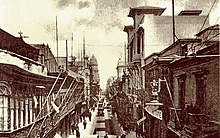Jirón de la Unión
Paseo de la República | |
| Construction | |
|---|---|
| Completion | 1535 |
The Jirón de la Unión, or Union Street, is a pedestrian street located in the Historic Centre of Lima, part of the capital of Peru. For many decades it was the most important boulevards of the city, often described as the most aristocratic, where many of the most affluent citizens of the city and most powerful men around the world would meet. Subsequently, with the deterioration of the center of Lima, the Jirón de la Unión lost its aristocratic character and became completely commercialized.
History
The Jirón de la Unión was built by
In 1535, The founder of
In 1862, with the adoption of a new system of nomenclature, the street ceased to be the axis on which the city was planned on. Thus, streets intersecting with the Jirón de la Unión had two separate names, one for their west side and another for the east.

At the start of the republican era, the Jirón de la Unión developed various pubs and restaurants as well as imported goods stores and jewelers. This caused upper-class Limans to frequent this roadway. Until the 1950s, the term irse a jironear was used when coming to the street in dress clothing. At this time, citizens of Lima at the most distinguished cultural, political, artistic and social levels could be found in the street's various cafés. As Peruvian writer Abraham Valdelomar once said, "Peru is Lima, Lima is the Jirón de la Unión, the Jirón de la Unión is the Palais Concert, and I am the Palais Concert". This phrase well reflects the impact this street had on the economic and social aspects of the city's daily life.
In 1954, the Casa Monterrey supermarket, the first such chain in the country, opened its first store in the stret's 54th block.[1][2]

In the 1970s, the third through ninth blocks of the street were restricted solely for pedestrian use. In the 1980s, the
Currently, the Jirón de la Unión has returned to being a commercial center; however, it has long lost its aristocratic character. The last change that has been made is the demolition of the concrete benches placed in the 1970s that were built with the intent to pedestrianize the road. These have been replaced with new benches inscribed with the coat of arms of each of the different departments of Peru.
Old names for the Jirón de la Unión
From the foundation of Lima, and until 1862, streets had a different name for each individual block. In this sense, one avenue in reality was made up of a variety of different streets. For this reason, before it was called the Jirón de la Unión, each of its eleven blocks had a different name.
- Block 1: named Puente de Piedra for the bridge that was built there and which unites downtown Rimac District.
- Block 2: named Palace for the Palace of Government of Peruwhich is located on this block
- Block 3: named Portal of the Scribes as the city hall was located on this block as well as the scribes offices during the Viceroyalty of Peru.
- Block 4: named Mercaderes for the large amount of commerce conducted on this street
- Block 5: named Espaderos for the various establishments for the fabrication and sale of swords and other knives which, in the 17th century, existed on this block.
- Block 6: named La Merced for the Church of La Merced which is located on this block
- Block 7: named Baquijano. Until the end of the 18th century, this block was called Gurmendi because the estate of Don Bernardo de Gurmendi, who was a member of the king's court, was located on this block. In 1730 it was renamed Baquijano because the manor of the don Juan Bautista de Baquijano y Urigoen was erected there
- Block 8: named Boza because the house of the Marquese of Boza was located there
- Block 9: named Plaza Micheo for the plaza located there
- Block 10: named Belen. In 1613 this block was named Paula Piraldo, whose estate occupied this location. In 1842, the land was sold to the monks of the Heart of Jesus and Maria who established the Belen School at this location
- Block 11: Named Juan Simon. Occupied what constituted as the city limit and intersected with the Lima City Walls. It was named for Juan Simon, a land owner
Route
The Jirón de la Unión begins its route at the
The
The
After the intersection with Emancipation Avenue, the seventh block is the location of the since-demolished Palais Concert. After this block, the Jirón is made up of casinos and restaurants. The ninth block his home to a Cineplanet and the commercial galleries of Via Vento and Boza, which are deteriorated and semi-vacant. The first
The ninth block borders the eastern side of the
The tenth and eleventh blocks are the least traversed of any of the other blocks, and there are a greater number of restaurants and travel agencies. The Rimac Building is located on the last block of the Jirón de la Unión marking the beginning of
See also
References
- ^ Tolentino, Scheila (2022-09-13). "Monterrey: ¿por qué fracasó uno de los primeros supermercados del Perú?". La República.
- ^ "Supermercados Monterey: ¿Por qué cerró una de las cadenas más populares del Perú?". 2022-08-15.
- (in Spanish) Bromley, Juan. Las viejas calles de Lima. Lima: Municipalidad Metropolitana de Lima. Gerencia de Educación, Cultura y Deportes. Edilibros; 2005.
External links
- (in Spanish) "Nueva forma de jironear por la Unión" newspaper article by El Comercio

